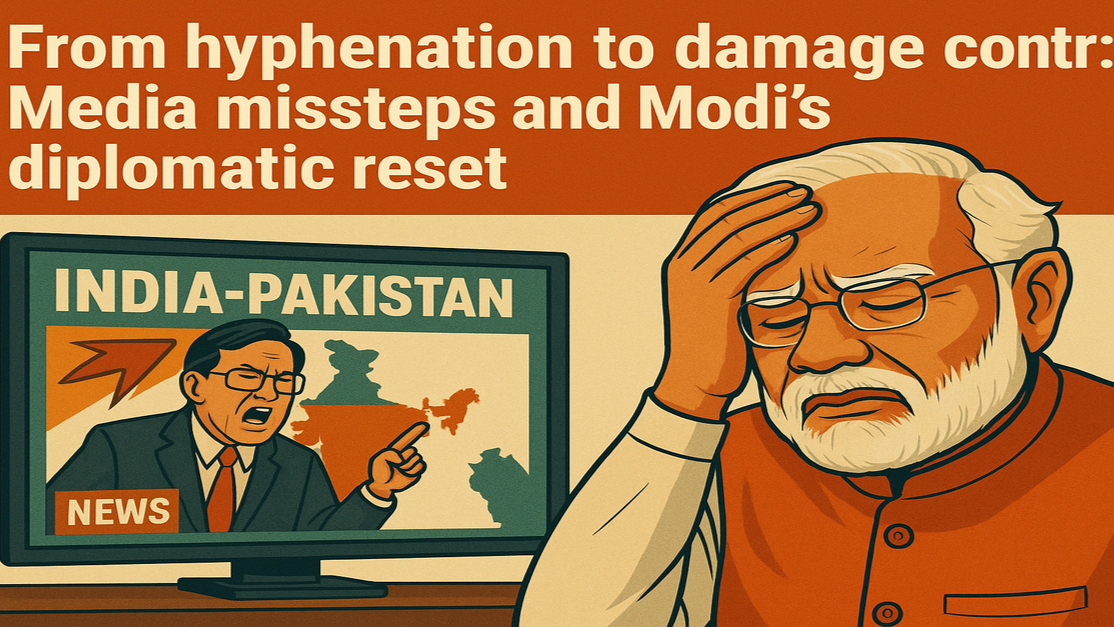 For years, Indian foreign policy has sought to de-hyphenate itself from Pakistan—to be viewed not as one half of a regional rivalry, but as a rising global power in its own right. Yet in a bitter twist of irony, it wasn’t Pakistani propaganda or foreign policy that reinserted the hyphen—it was mostly India’s own electronic media.
For years, Indian foreign policy has sought to de-hyphenate itself from Pakistan—to be viewed not as one half of a regional rivalry, but as a rising global power in its own right. Yet in a bitter twist of irony, it wasn’t Pakistani propaganda or foreign policy that reinserted the hyphen—it was mostly India’s own electronic media.
When tensions with Pakistan escalated in early 2025, the Line of Control wasn’t the only frontier that lit up. Inside air-conditioned studios outfitted with green screens and ticker-tape fury, Indian television descended into unrestrained, hyperbolic nationalism. While the armed forces and diplomats maintained professionalism and restraint, the media declared a full-scale war—on reality TV.
In a frenzy of ratings-driven theatrics, one channel breathlessly announced that five Pakistani cities had been captured. Not to be outdone, another claimed it was twenty-five. Then came the proud declaration that “half of Pakistan is now under Indian control.” Geography, evidently, was the first casualty.
Next came breathless, fact-free reports that Pakistan’s Prime Minister Shehbaz Sharif and Army Chief General Asim Munir were “preparing to flee the country.” No sources. No verification. Just red tickers and righteous fury.
Across the border, Pakistani channels matched the noise, decibel for decibel—every Indian strike was “ineffective,” every Pakistani response was “decisive,” and, in perhaps a pioneering contribution to military metrics, one anchor claimed Pakistan’s army had “prevailed spiritually.”
But while both sides engaged in televised war games, India’s media spectacle proved particularly damaging. Why? Because the world expects better from India. As the world’s largest democracy and a rising power often compared favorably to Pakistan’s instability, India has worked hard diplomatically to position itself as a responsible stakeholder in global affairs.
And yet, instead of responding with restraint, facts, or maturity, several major Indian news networks chose to put on a show—full of nationalistic theatrics, wild claims, and shouting matches. At a time when the world was watching, the Indian media blurred the very distinction that Indian diplomacy has spent decades clarifying.
Worse still, operational security was casually compromised. One anchor proudly revealed that “special forces have just entered Sector 4C!”—apparently unaware that such information was classified.
While missiles were (allegedly) flying and commandos were sneaking around silently, India’s Godi media was already in full Bollywood War Epic mode—complete with dramatic music, zoom-ins on maps, and a special guest: the ever-irate Pakistani “expert” who was, let’s be honest, more of a rent-a-villain than a credible analyst. Clarity was missing, facts were optional—but TRPs soared like a BrahMos on Red Bull.
Eventually, a ceasefire was brokered. And here, Trump entered repeatedly with characteristic bombast to re-hyphenate India with Pakistan—and the world witnessed some brazen credit poaching, about which I’ve already written elsewhere.
Both governments emerged declaring victory. This surprised no one—especially not the domestic audiences who had already been fed a steady diet of triumphalist fiction by their respective media. The Americans, content with their role as peacemakers, saw no reason to challenge these parallel claims.
Indian TV anchors, too, returned triumphant. Having squeezed every ounce of drama from the conflict, they pivoted seamlessly to their next obsessions: Bollywood weddings, celebrity spats, and reports of alien sightings in Rajasthan.
But beneath the surface, lasting damage had been done. The reckless performance of India’s media—marked by jingoism, misinformation, and disregard for operational secrecy—offered international observers ample reason to question India’s strategic maturity. This was especially disheartening given that India held a clear military and diplomatic edge up to the events near Pahalgam. Post-Pahalgam, however, Pakistan’s aggressive diplomatic maneuvering, India’s premature accusations, and America’s pressure tactics blurred that advantage. With the U.S. reportedly using coercive language to compel India into accepting the ceasefire, the perception of parity was revived—and the media’s sensationalism sealed the hyphen’s return.
Yet all is not lost. In the wake of this episode, the Indian government, under Prime Minister Modi’s direction, has launched a calibrated diplomatic counteroffensive. Senior parliamentarians, seasoned former diplomats, and strategic community leaders are being dispatched to key capitals—Washington D.C., London, Brussels, Tokyo, Canberra, and beyond—to articulate India’s perspective with clarity and conviction. Their brief: to highlight the asymmetry in provocation and response, and reinforce India’s position as a responsible, restrained power. So much has been said about dehyphenation with Pakistan, it should not seem that that is our main goal—keeping the dependable nations of the world with us is.
This effort signals a recognition in New Delhi that while media missteps may have undermined India’s messaging, it is still possible to reclaim the narrative—through mature statecraft and unapologetic truth-telling. Spades must be called spades. And the story of what transpired—both in battle and on the airwaves—must be told well, and not overdramatically.